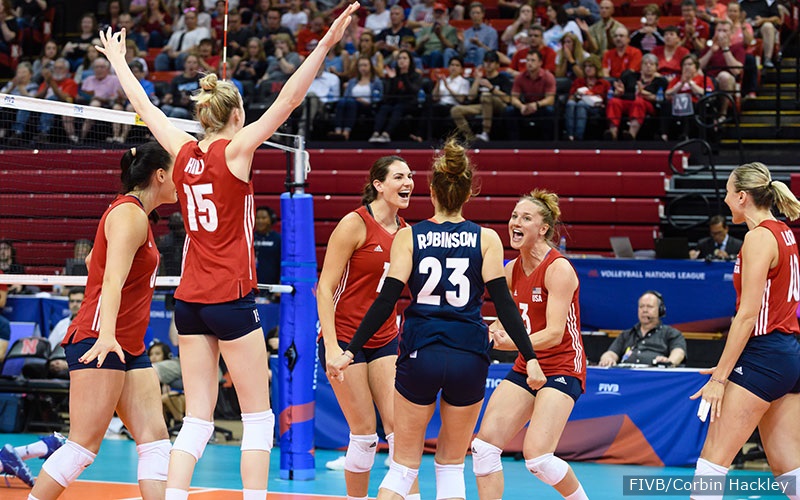A Very Volleyball-Specific ACL Injury Prevention Plan: Offside Hitting With John Kessel, Director of Sport Development, USA Volleyball, Colorado Springs, CO
John Kessel has coached volleyball since 1971 and has been with USA Volleyball since 1985. He has been director of the Jr. Olympic Volleyball and Beach Volleyball programs, the High Performance program, regional operations, national beach program and team leader for the team in Sydney where they won a gold medal in men's play, and then in 2004 in Athens for the Women’s Bronze medal winning USA Sitting team. In Volume 8, Number 4 of “Performance Conditioning Volleyball” John introduced the concept of proper reaction, anticipation and reading skills in preventing injury. This article addresses, in greater detail, how the occurrence of ACL injuries happen and what can be done to prevent them. [Ed.] The concept of offside skills is not new to sport. In basketball a player dribbles with either hand. In lacrosse the players must have the ability to shoot from either side. In soccer the players have to be able to put the ball in the net using either foot. In volleyball, however, we develop only one-handed hitters. Our game systems are designed for the right handed player, who make up over 90 percent of those playing. That’s why our setters generally wait as targets to the right side of the court, so that the middle hitter (zone 3) and outside hitter (zone 4) are hitting “on-hand” as it is called. Nevertheless, it is important for volleyball players to be able to hit with their non- dominant hand. It’s not rocket science or hard to achieve. The thing that coaches have to do is give the kids time at practice to learn it. This should be done at a young age, and over the net in warm up games (standing on the ground mostly), or in your form of “pepper” – just a minute or two every practice. The younger the player is when s/he gets good at using both hands the better the athlete will be in the air when it comes time to adjust once they have taken off in the jump. While offside hitting is important at all levels, it’s most important at the youngest age because younger athletes are the ones that make the biggest errors in judgment. The decision making process takes place on the ground. A young athlete needs to be able to use the opposite hand as the ball drifts to the left side of the body. The first shot we teach is the across the body motion that would save the ball. The athlete will swing with the left hand and bring the ball from left to right over the net dropping the ball in zone 4 because of the radical angle. Any other angle would hit the antenna.
The Occurrence of ACL
This is how an ACL injury occurs. An athlete misjudges a ball. It’s match point or the middle of practice and the coach is screaming, “Hit every ball.” The athlete jumps and the only way to save it is by leaning way over to the left to hit the ball with the right hand. This action tilts the body to the left and creates a dangerous situation of landing, full force, off-balance over the left leg and therefore potentially blowing the ACL or damaging the ankle. As the foot lands, the knee takes the torque as the player finishes the landing process. This happens more in the front row, with the nearby antenna dictating the reality of success or failure in getting the ball over the net, but it also occurs in misjudged back row attacks. Current research indicates that too many ACL injuries occur because of improper landing. The scenario just presented demonstrates how this improper landing can occur more often than we would like to think in the sport of volleyball. The next scenario in making a save is when the athlete jumps in the middle and the ball is shot past the body during a shoot or faster set. In this case a right side dominant athlete could turn and hit the ball in the court with the right hand, which again would put the landing in a potentially awkward position. Alternatively, the player could hit the ball back with the left hand. This isn’t an actual hit but more of a tip to an open space. Based on realities of the game and what I see happen in a lot of misjudged balls, this is an important skill to have. A final scenario occurs when a right-handed player goes running in on the right side of the court, zone 2, and realizes that the ball is too far over to the left. Normally what the athlete does is rotate to their left and hit the ball with the right hand because on that side, the player is still hitting into the court. As it is totally the opposite of what is seen in our zone 4 outside hit we presented in the first scenario, the need to hit the ball with the left side is diminished greatly in this instance.
Prevention Techniques
Learning to hit offside can be a simple process. Two athletes, each right side dominant, stand at the net on opposite sides. The first athlete turns the right shoulder to point at the athlete on the opposite side. The ball is set to the left side of the body and the athlete swings across the body, left to right, bringing the ball over to the athlete on the other side. The athlete on the other side with the right shoulder facing his counterpart on the other side hits the ball back. The two trade off their non-dominate hands. The bottom line is the coach needs to develop both sides. In playing pepper, over the net pepper, or in game that might be played one to two minutes of non-dominant hand, hitting should be done until the skill becomes automatic. Making it automatic is important because the players, for the most part, don’t realize that the solution is reached after take-off. If athletes always knew where to jump they would jump in the right place. For left handers, this non-dominant development is even more important because when they hit to zones 3 and 4, they are often set the ball as if they were right handed and the set is delivered too far to their right. As a result, left-handers develop their non-dominant (right) hand earlier on because they are constantly getting right-handed sets. The most common result is the lefty will hit to zone 2 on the right side of the court. I’ve experienced knee injury first hand. When I was 19 I received a set put wide to my right on the right side and couldn’t do anything but hit the ball with my left hand (I’m left side dominant). To keep the ball in play over the net, I leaned far to the right in air, landed one legged on my right leg and blew my right knee. So, for left-handers more time should be spent working off-hand hitting techniques because the error to a right-hander is usually done by the player making an error in judgment. The error for a lefthander is usually done far more often, as setters are all used to setting right handers. If they hit zones 3 and 4 they are getting set more often as if they were right handed by the setter who doesn’t make the slight adjustment to get the ball to the players’ left shoulder.
Landing Considerations
As I’ve stated before, recent research has indicated that ACL injuries may occur because of improper landing. The problem occurs when an athlete is reaching out and hitting the ball over the left side of the body. How long is the athlete in the air? United States Olympic Committee research shows from a half to two thirds a second overall with .25- .32 seconds to contact and then .25-.32 seconds to landing. Therefore after the hit, the athlete will too often land before s/he has a chance to readjust the body to land with good technique. There just isn’t enough time to adjust otherwise. So, by programming athletes to hit off-hand rather than attempt a dominate hand hit, the landing issue takes care of itself because when hitting with the non-dominate hand the landing technique is not compromised and the landing is done with good vertical form. In the end, we need to give all players the tools to solve these judgment errors, which happen with little time to adjust, by training the movement first one the ground, and then being able to use both arms in the air as needed.






